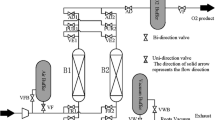Abstract
A new PSA process has been proposed and experimentally verified. This process was operated with a radial flow geometry under a cycle time less than 30 seconds. It has been showed that enriched oxygen could be produced when air was fed inward. The same system showed virtually no separation effect if the feed direction was reversed. The change of separation efficiency upon flow reversal was most significant when small adsorbent particles were employed. A ø 200×75 mm annular packing with 3 µm particles of zeolite 5A was able to produce 60% purity oxygen from air. The effect of flow direction on system performance confirmed the importance of flow resistance distribution. In radial flow geometry, most of the flow resistance was located near the center of the disk. The relative small pressure gradient at the feed end enabled a better absorbent utilization during the inward feed step, and a more effective desorption during the vent step. The same principle could be extended to other geometric configurations.
Similar content being viewed by others
References
Doong, S.J. and R.T. Yang, “The role of pressure drop in PSA,”Adsorp. and ion exchange: Fundam. and Appl., M.D. LeVan (Eds.), pp. 145–154, AIChE Symp. Ser., No. 264,84, 1988.
Jones, R.L. and G.E. Keller, US patent 4,194,892 (1980).
Jones, R.L. and G.E. Keller, “Pressure—Swing parametric pumping—a new adsorption process,”J. Sep. Proc. Technol.,2, 17–23 (1981).
Keller, G.E. and R.L. Jones, “A new process for adsorption separation of gas mixture,”Adsorp. and ion exchange with synthetic zeolites, W.H. Flank (Ed.), pp. 275–186, ACS Symp. Ser. No. 135, 1980.
Kowler, D.E. and R.H. Kadlec, “The optimal control of a periodic adsorber: Experiment and Theory,”AIChEJ.,18, 1207–1219 (1972).
Kumar, R., W.C. Kratz, D.E. Guro, D.L. Rarig, and W.P. Schmidt, “Gas mixture fraction to produce two high purity products by PSA,”Sep. Sci. Technol.,27(4), 509–522 (1992).
Pritchard, C.L. and G.K. Simpson, “Design of an oxygen concentrator using the RPSA principle,”Chem. Eng. Res. Des.,64, 467–471 (1986).
Rota, R. and P.C. Wankat, “Intensification of pressure swing adsorption processes,”AIChE J.,36, 1299–1312 (1990).
Rota, R. and P.C. Wankat, “Radial flow pressure swing adsorption,” Proc.Adsorp. Proc. for gas sep., F. Meunier and M.D. LeVan (Eds.), pp. 143–148, GFGP, Nancy, France, 1991.
Turnock, P.H. and R.H. Kadlec, “Separation of nitrogen and methane via periodic adsorption,”AIChE J.,17, 335–342 (1971).
Wu, S.T., MS thesis, National Central Univ. Taiwan ROC (1993).
Author information
Authors and Affiliations
Rights and permissions
About this article
Cite this article
Chiang, A.S.T., Hong, M.C. Radial flow rapid pressure swing adsorption. Adsorption 1, 153–164 (1995). https://doi.org/10.1007/BF00705002
Received:
Revised:
Accepted:
Issue Date:
DOI: https://doi.org/10.1007/BF00705002




